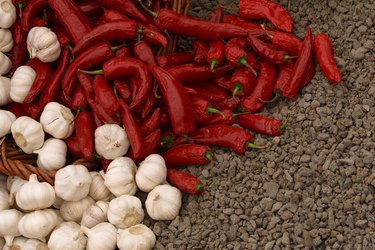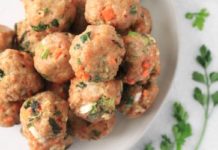Things You’ll Need
-
Dairy products (optional)
-
Nut butters (optional)
-
Acidic juices (optional)
-
Sugar or sugar syrups (optional)
 Garlic-chili sauces with varying degrees of heat are characteristic of Indian cooking. Image Credit: Photos.com/Photos.com/Getty Images
Garlic-chili sauces with varying degrees of heat are characteristic of Indian cooking. Image Credit: Photos.com/Photos.com/Getty Images
Underestimating the heat of a chili pepper or seasoning too aggressively with spice can ruin an otherwise flawlessly executed dish, rendering it too hot to be edible. Red and green chilis, chili sauces and powders are key to flavoring many Indian cuisines including spicy noodle dishes. If the level of spiciness winds up being too intense, you can beat the heat by removing the offending chili peppers, adding cooling ingredients or counteracting the heat.
Video of the Day
Step 1
Remove chili peppers from your noodle dish the second you realize it has gotten too hot. Chili peppers contain an ingredient called capsaicin which is responsible for the amount of heat present; removing chili peppers from the dish prevents more capsaicin from being released.
Step 2
Cool down heat with the addition of ingredients that tame heat such as dairy products and nut butters. Consider the dish before you add a taming ingredient to ensure that you are complementing the existing flavors and textures. Milk soothes and thins out sauces while sour cream and yogurt lend creaminess. Peanut butter, almond butter or tahini can also be used to tone down heat and pair well with dishes that use peanut or sesame oil.
Step 3
Add a squirt of acidity or a spoonful of sugar to help counteract spiciness. Lemon juice, lime juice and vinegar help cut through heat, but be careful to introduce only a little at a time or your dish will turn sour. The addition of sugar is also a great way to neutralize heat. Sugar, honey or agave syrup can be added to balance out heat; just be careful not to add too much or your spicy noodles will wind up tasting more like dessert. You can also try combining an acid and a sugar together to double-team the heat.
Tip
If feasible, double the recipe, omitting the source of the heat from the second batch.
The amount of capsaicin present can vary widely among individual peppers depending on environmental factors and maturity, making the level of spiciness slightly unpredictable. Remove the membrane and seeds, which house the majority of the heat, to reduce the resulting spiciness of a dish.










































